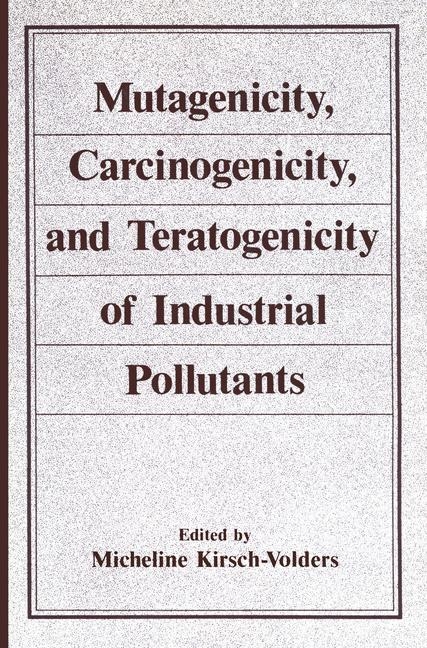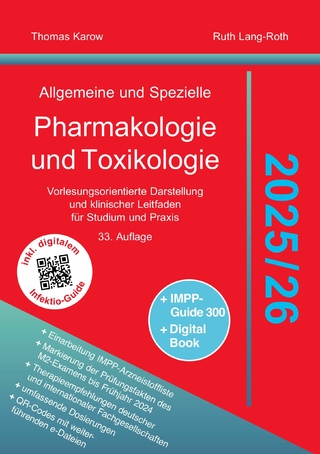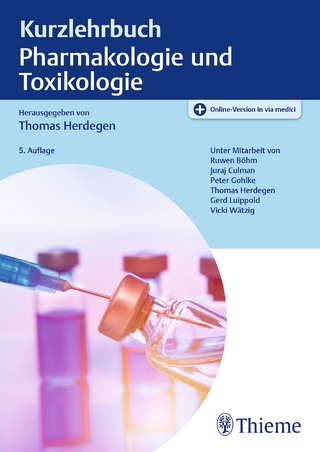
Mutagenicity, Carcinogenicity, and Teratogenicity of Industrial Pollutants
Kluwer Academic/Plenum Publishers (Verlag)
978-0-306-41148-9 (ISBN)
- Titel ist leider vergriffen;
keine Neuauflage - Artikel merken
Introduction: Mutagenesis as a Health Problem.- 1 Molecular Mechanisms of Mutagenesis and Carcinogenesis.- I: Cellular Factors which Modify the Expression of Mutagenic Action Into Genetic Lesions.- 1. The Nature of the Target.- 1.1. Direct Mutagenesis with DNA as Target.- 1.2. Indirect Mutagenesis through Non-DNA Targets.- 1.2.1. Spindle Inhibitors.- 1.2.2. Action on Enzymatic Processes.- 1.3. Role of the Cell Cycle.- 1.4. Interspecies Differences.- 2. The Nature of the Mutagen.- 2.1. True Mutagens.- 2.2. Turbagens.- 3. An Overview of DNA Repair Processes.- 3.1. Prereplicative Error Correction.- 3.2. Replicative Error Avoidance.- 3.3. Post-Replicative Error Avoidance.- 3.4. Post-Replicative DNA Repair (PRR).- 3.5. Direct and Indirect Mutagens.- 3.6. Why SOS Repair?.- 4. Metabolization, Synergism, and Protection.- II: Relation Between Mutation, Repair, and Chromosome Aberration.- 5. Estimation of DNA Damage.- 6. Mechanisms Involved in Structural Chromosome Aberrations.- 6.1. Chromosome Breaks and Exchanges.- 6.1.1. Chromosome Breaks.- 6.1.2. Chromosome Exchanges.- 6.2. Chromosome Gaps.- 6.3. Sister Chromatid Exchanges.- 7. Significance of Aneuploidy.- III: Chromosomal Alterations and Carcinogenesis.- 8. Carcinogens and Chromosomal Rearrangements.- 9. Chromosomal Rearrangement Associated with Carcinogenesis.- 10. Chromosomal Rearrangements in Human Cancer-Prone Syndromes.- 11. Carcinogenic Chromosomal Rearrangement.- 12. Induction of Chromosomal Rearrangement.- 13. Role of Chromosomal Rearrangement in Carcinogenesis.- 14. Mechanisms of Carcinogenesis.- References.- 2 Mutagenicity, Carcinogenicity, and Teratogenicity of Industrially Used Metals.- 1. General Considerations.- 1.1. Risks and Their Assessment.- 1.2. Metabolism and Toxicity.- 1.3. Mechanisms of Metal Toxicity.- 1.4. Mutagenesis: Tests and Their Interpretation.- 1.5. Carcinogenesis: Mechanisms and Evaluation.- 1.6. Action on the Developing Organism.- 2. Arsenic.- 2.1. Exposure, Occurrence, and General Toxicity.- 2.2. Mutagenesis.- 2.3. Carcinogenesis.- 2.4. Teratogenesis.- 3. Beryllium.- 3.1. Exposure, Occurrence, and General Toxicity.- 3.2. Mutagenesis.- 3.3. Carcinogenesis.- 4. Cadmium.- 4.1. Exposure, Occurrence, and General Toxicity.- 4.2. Mutagenesis.- 4.3. Carcinogenesis.- 4.4. Teratogenesis.- 5. Chromium.- 5.1. Exposure, Occurrence, and General Toxicity.- 5.2. Mutagenesis.- 5.3. Carcinogenesis.- 5.4. Teratogenesis.- 6. Lead.- 6.1. Exposure, Occurrence, and General Toxicity.- 6.2. Mutagenesis.- 6.3. Carcinogenesis.- 6.4. Teratogenesis.- 7. Mercury.- 7.1. Exposure, Occurrence, and General Toxicity.- 7.2. Mutagenesis.- 7.3. Carcinogenesis.- 7.4. Teratogenesis.- 8. Nickel.- 8.1. Exposure, Occurrence, and General Toxicity.- 8.2. Mutagenesis.- 8.3. Carcinogenesis.- 8.4. Teratogenesis.- 9. Other Metals.- 9.1. Mutagenesis.- 9.2. Carcinogenesis.- 9.3. Teratogenesis.- 10. Conclusions.- References.- 3 Mutagenicity, Carcinogenicity, and Teratogenicity of Insecticides.- 1. Introduction.- 2. Chemical and Biochemical Properties.- 2.1. Chlorinated Insecticides.- 2.1.1. Chemical Properties.- 2.1.2. Biochemical Properties.- 2.2. Organophosphorus Insecticides.- 2.2.1. Chemical Properties.- 2.2.2. Biochemical Properties.- 2.3. Carbamate Insecticides.- 2.3.1. Chemical Properties.- 2.3.2. Biochemical Properties.- 2.4. Miscellaneous Insecticides.- 2.4.1. Chemical Properties.- 2.4.2. Biochemical Properties.- 3. Mutagenicity.- 3.1. Chlorinated Insecticides.- 3.1.1. DDT and Related Compounds.- 3.1.2. Cyclodienes: Aldrin and Dieldrin.- 3.1.3. Cyclodienes: Heptachlor and Chlordane.- 3.1.4. Chlordecone and Mirex.- 3.1.5. Lindane and Paradichlorobenzene.- 3.1.6. Toxaphene.- 3.2. Organophosphorus Insecticides.- 3.2.1. Prokaryotes.- 3.2.2. Eukaryotes.- 3.3. Carbamate Insecticides.- 3.3.1. Carbaryl.- 3.3.2. Other Carbamate Insecticides.- 3.4. Miscellaneous Insecticides.- 4. Carcinogenicity.- 4.1. Chlorinated Insecticides.- 4.1.1. DDT and Related Compounds.- 4.1.2. Cyclodienes: Aldrin and Dieldrin.- 4.1.3. Cyclodienes: Chlordane and Heptachlor.- 4.1.4. Chlordecone and Mirex.- 4.1.5. Lindane.- 4.1.6. Toxaphene.- 4.2. Organophosphorus Insecticides.- 4.3. Carbamate Insecticides.- 4.4. Miscellaneous Insecticides.- 5. Teratogenicity.- 5.1. Chlorinated Insecticides.- 5.2. Organophosphorus Insecticides.- 5.3. Carbamate Insecticides.- 5.4. Miscellaneous Insecticides.- 6. Discussion and Conclusions.- References.- 4 Mutagenicity, Carcinogenicity, and Teratogenicity of Industrially Important Monomers.- 1. Introduction.- 2. Vinyl Chloride.- 2.1. Toxicity.- 2.2. Metabolism.- 2.3. Mutagenicity.- 2.4. Carcinogenicity.- 2.5. Teratogenicity and Embryotoxicity.- 3. Acrylonitrile.- 3.1. Toxicity.- 3.2. Metabolism.- 3.3. Mutagenicity.- 3.4. Carcinogenicity.- 3.5. Teratogenicity and Embryotoxicity.- 4. Styrene.- 4.1. Toxicity.- 4.2. Metabolism.- 4.3. Mutagenicity.- 4.4. Carcinogenicity.- 4.5. Teratogenicity and Embryotoxicity.- 5. Vinylidene Chloride.- 5.1. Toxicity.- 5.2. Metabolism.- 5.3. Mutagenicity.- 5.4. Carcinogenicity.- 5.5. Teratogenicity and Embryotoxicity.- 6. Butadiene.- 6.1. Toxicity.- 6.2. Metabolism.- 6.3. Mutagenicity.- 6.4. Carcinogenicity.- 6.5. Teratogenicity and Embryotoxicity.- 7. Chlorobutadiene.- 7.1. Toxicity.- 7.2. Metabolism.- 7.3. Mutagenicity.- 7.4. Carcinogenicity.- 7.5. Teratogenicity and Embryotoxicity.- 8. Hexachlorobutadiene.- 8.1. Toxicity.- 8.2. Metabolism.- 8.3. Mutagenicity.- 8.4. Carcinogenicity.- 8.5. Teratogenicity and Embryotoxicity.- 9. General Discussion and Conclusions.- References.- 5 Mutagenicity, Carcinogenicity, and Teratogenicity of Halogenated Hydrocarbon Solvents.- 1. Introduction.- 2. Chloroform.- 2.1. Absorption, Distribution, Metabolism, and Excretion.- 2.2. Toxicity.- 2.3. Mutagenicity and Carcinogenicity.- 2.4. Embryotoxicity and Teratogenicity.- 3. Carbon Tetrachloride.- 3.1. Absorption, Distribution, Metabolism, and Excretion.- 3.2. Toxicity.- 3.3. Mutagenicity and Carcinogenicity.- 3.4. Embryotoxicity and Teratogenicity.- 4. Trichlorethylene (TCE).- 4.1. Absorption, Distribution, Metabolism, and Excretion.- 4.2. Mutagenicity and Carcinogenicity.- 4.3. Embryotoxicity and Teratogenicity.- 5. 1,2-Dichloroethane.- 5.1. Absorption, Distribution, Metabolism, and Excretion.- 5.2. Toxicity.- 5.3. Mutagenicity and Carcinogenicity.- 5.4. Teratogenicity and Embryotoxicity.- 6. Tetrachloroethylene.- 6.1. Absorption, Distribution, Metabolism, and Excretion.- 6.2. Toxicity.- 6.3. Mutagenicity and Carcinogenicity.- 6.4. Embryotoxicity and Teratogenicity.- 7. Dichloromethane.- 7.1. Absorption, Distribution, Metabolism, and Excretion.- 7.2. Toxicity.- 7.3. Carcinogenic and Mutagenic Effects.- 7.4. Teratogenicity and Embryotoxicity.- 8. 1-1,1-Trichloroethane.- 8.1. Absorption, Distribution, Metabolism, and Excretion.- 8.2. Toxicity.- 8.3. Mutagenicity and Carcinogenicity.- 8.4. Embryotoxicity and Teratogenicity.- 9. Conclusions.- References.- Conclusions.
| Erscheint lt. Verlag | 1.1.1984 |
|---|---|
| Zusatzinfo | XIV, 336 p. |
| Verlagsort | New York |
| Sprache | englisch |
| Themenwelt | Medizin / Pharmazie ► Medizinische Fachgebiete ► Pharmakologie / Pharmakotherapie |
| Medizin / Pharmazie ► Pharmazie | |
| Studium ► 2. Studienabschnitt (Klinik) ► Pharmakologie / Toxikologie | |
| Naturwissenschaften ► Biologie | |
| ISBN-10 | 0-306-41148-2 / 0306411482 |
| ISBN-13 | 978-0-306-41148-9 / 9780306411489 |
| Zustand | Neuware |
| Haben Sie eine Frage zum Produkt? |
aus dem Bereich


